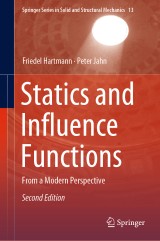Details

Statics and Influence Functions
From a Modern PerspectiveSpringer Series in Solid and Structural Mechanics, Band 13 2nd ed. 2021
|
CHF 142.00 |
|
| Verlag: | Springer |
| Format: | |
| Veröffentl.: | 25.11.2020 |
| ISBN/EAN: | 9783030558895 |
| Sprache: | englisch |
Dieses eBook enthält ein Wasserzeichen.
Beschreibungen
<div><p>This extended and revised second edition is intended for engineering students and researchers working with finite element methods in structural and mechanical analysis. Discussing numerical structural analysis from first mechanical and mathematical principles, it establishes the central role of influence functions (Green's functions) in finite element analysis, reanalysis, sensitivity analysis, parameter identification and in optimization, with a particular focus on computational aspects and questions of accuracy. It also presents a one-click reanalysis, a new technique that allows instantaneous modifications to a structure to be made by clicking on single elements. Lastly, the book features four programs that can be downloaded for the solution of the Poisson equation, 2-D elasticity, plate-bending problems and planar frames. </p></div><div><br></div>
Foundation.- Betti's Theorem.- Finite Elements.- Betti Extended.- Stiffness Changes and Reanalysis.- Singularities.- Mixed formulations.- Nonlinear Problems.
Friedel Hartmann was professor for Civil Engineering at the University of Kassel, Germany. He authored the book "Greens' Functions and Finite Elements" and "Structural Analysis with Finite Elements" both published by Springer.
<p>This extended and revised second edition is intended for engineering students and researchers working with finite element methods in structural and mechanical analysis. Discussing numerical structural analysis from first mechanical and mathematical principles, it establishes the central role of influence functions (Green's functions) in linear computational mechanics. The main features of the book are mentioned below.</p>
<p>· Introducing Green's first and second identity as the core theorems of statics and mechanics. Formulation of the variational and energy principles of mechanics with an emphasis on the computational aspects and on the qualitative features of variational solutions.</p>
<p>· Derivation of influence functions from duality principles, the distinction between weak and strong influence functions, the difference between monopoles and dipoles and how amputated dipoles leadto singularities, and how singularities on the boundary pollute the solution inside the domain - an unavoidable effect in 2-D and 3-D.</p>
· A detailed discussion of the various features of the finite element method and the key role of the notion of “shake-equivalence" as originally introduced by Turner et alt. Establishing that in linear finite element analysis the accuracy depends on the accuracy of the influence functions. Introducing Betti extended as a core theorem of finite element analysis.<p></p>
<p>· A systematic treatment of the role which Green's functions play in reanalysis, sensitivity analysis, parameter identification and in optimization. Explaining why averaging material parameters succeeds and how local stiffness changes can be identified with the action of equilibrium forces f+.</p>
<p>· Presenting a new technique, one-click reanalysis, which allows to make modifications to a structure by clicking on single elements and seeing directly the new shape, bypassing the need to solve the modified system.</p>
<p>· Four programs for the solution of the Poisson equation, 2-D elasticity, plate-bending problems and planar frames are offered for download in this second edition. These are all-purpose programs but with a particular emphasis on influence functions. The frame program also demonstrates one-click reanalysis.</p><br>
<p>· Introducing Green's first and second identity as the core theorems of statics and mechanics. Formulation of the variational and energy principles of mechanics with an emphasis on the computational aspects and on the qualitative features of variational solutions.</p>
<p>· Derivation of influence functions from duality principles, the distinction between weak and strong influence functions, the difference between monopoles and dipoles and how amputated dipoles leadto singularities, and how singularities on the boundary pollute the solution inside the domain - an unavoidable effect in 2-D and 3-D.</p>
· A detailed discussion of the various features of the finite element method and the key role of the notion of “shake-equivalence" as originally introduced by Turner et alt. Establishing that in linear finite element analysis the accuracy depends on the accuracy of the influence functions. Introducing Betti extended as a core theorem of finite element analysis.<p></p>
<p>· A systematic treatment of the role which Green's functions play in reanalysis, sensitivity analysis, parameter identification and in optimization. Explaining why averaging material parameters succeeds and how local stiffness changes can be identified with the action of equilibrium forces f+.</p>
<p>· Presenting a new technique, one-click reanalysis, which allows to make modifications to a structure by clicking on single elements and seeing directly the new shape, bypassing the need to solve the modified system.</p>
<p>· Four programs for the solution of the Poisson equation, 2-D elasticity, plate-bending problems and planar frames are offered for download in this second edition. These are all-purpose programs but with a particular emphasis on influence functions. The frame program also demonstrates one-click reanalysis.</p><br>
Explains how influence functions can be computed with finite elements Shows that finite element programs use influence functions to calculate the results Demonstrates how the error in the influence functions affects finite element results
Diese Produkte könnten Sie auch interessieren:

Neutron Applications in Earth, Energy and Environmental Sciences

von: Liyuan Liang, Romano Rinaldi, Helmut Schober

CHF 177.00

Nanobioelectronics - for Electronics, Biology, and Medicine

von: Andreas Offenhäusser, Ross Rinaldi

CHF 118.00














